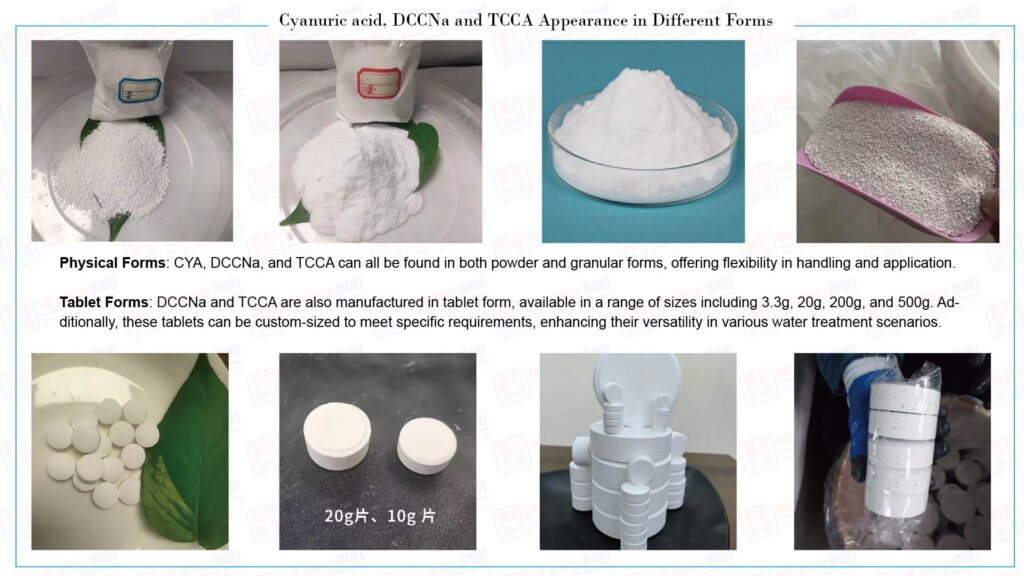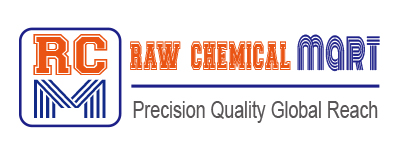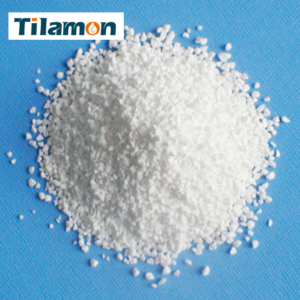Cyanuric acid (CYA) and its derivatives, such as sodium dichloroisocyanurate (DCCNa) and trichloroisocyanuric acid (TCCA), are essential compounds widely used in swimming pool disinfection and water treatment. These chemicals are available in various forms and packaging options to meet diverse application needs. Below is a detailed overview of the physical forms and packaging methods for CYA, DCCNa, and TCCA.
Part 1: Versatile Physical Forms for Water Treatment

CYA, DCCNa, and TCCA are available in multiple physical forms to ensure flexibility and ease of use in different water treatment scenarios:
- Powder and Granular Forms: All three compounds—CYA, DCCNa, and TCCA—are available in powder and granular forms, making them suitable for a wide range of applications.
- Tablet Forms: DCCNa and TCCA are also manufactured in tablet form, with standard sizes including 3.3g, 20g, 200g, and 500g. Custom-sized tablets can also be produced to meet specific requirements, enhancing their adaptability for various water treatment needs.
These diverse forms ensure that CYA, DCCNa, and TCCA can be effectively utilized in different contexts, providing tailored solutions for maintaining water hygiene and safety.
Part 2: Packaging Methods for DCCNa and TCCA Tablets

DCCNa and TCCA tablets are packaged using three primary methods, each designed to ensure safety, convenience, and efficiency during storage and transportation:
- 50L Plastic Drums with Liner Bags: The tablets are packed into 50L plastic drums, each containing a liner bag. Once sealed, the drum becomes an independent package, ready for shipping.
- Small Plastic Containers in 50L Drums: The tablets are packed into small plastic containers, with the inner diameter of the container matching the diameter of the tablets. This allows for the exact number of designed tablets to fit. These small containers are then placed into 50L plastic drums, forming an independent package.
- Small Plastic Containers in Cardboard Boxes: Similar to the second method, the tablets are packed into small plastic containers. However, these containers are then placed into cardboard boxes of the designed size, forming an independent package.
All three packaging methods are suitable for loading into containers for shipping, ensuring secure and efficient transportation.
Part 3: Packaging Options for CYA, DCCNa, and TCCA in Powder and Granular Forms

Cyanuric acid, sodium dichloroisocyanurate, and trichloroisocyanuric acid in powder and granular forms can be packaged in the following four formats to meet various storage and transportation needs:
- 50L Cardboard Drums with Plastic Liners: These drums are lined with plastic bags to protect the contents from moisture and contamination.
- 25 kg Plastic Woven Bags: A cost-effective and durable option for bulk packaging.
- 25L or 50L Plastic Drums: Ideal for smaller quantities, providing robust protection for the contents.
- Ton Bags (1000 kg): Suitable for large-scale industrial applications, offering efficient handling and storage for bulk quantities.
The packaging dimensions, logos, and text descriptions can be customized to meet specific customer requirements, ensuring a tailored solution for every need.
Conclusion
Cyanuric acid and its derivatives, DCCNa and TCCA, are available in a variety of physical forms and packaging options to cater to diverse water treatment applications. Whether in powder, granular, or tablet form, these compounds can be efficiently packaged using methods such as plastic drums, small containers, cardboard boxes, or bulk bags. Customizable packaging solutions further enhance their versatility, making them ideal for maintaining water hygiene and safety across different contexts.




